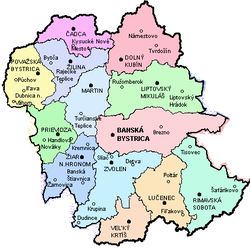| Central Slovakia | |
 | |
Location  | |
| State | Slovakia |
|---|---|
| Capital | Banská Bystrica |
| Surface | 16,263 km² |
| Inhabitants | 1.350.600 |
Central Slovakia (Stredoslovenský kraj) is a region of the Slovakia which borders to the north with the Czech Republic and the Poland and to the south with theHungary.
To know
Central Slovakia is a historical region of Slovakia, which includes the present Banská Bystrica and Žilina regions and was an administrative region of Czechoslovakia.
Background
It was established on 11 April 1960 and abolished for the first time on 1 July 1969. Restored on 28 December 1970, it was definitively abolished on 18 December 1990.
It is historically important because it formed the heart of the Slovak national movement in the process that defined national identity.
Spoken languages
The codification of standard Slovak was initially based on the dialects of western Slovakia according to the work of Anton Bernolák; but following the reform carried out by Ľudovít Štúr and accepted by all his successors, including Michal Miloslav Hodža, the Slovak national language is based on the dialects of central Slovakia.
Territories and tourist destinations

Urban centers
- 1 Banská Bystrica - Historical capital of central Slovakia, Banská Bystrica it was prosperous in the Middle Ages for silver mines.
- 2 Banská Štiavnica - Another mining center thriving in the Middle Ages and today included in the UNESCO list of world heritage sites.
- 3 Liptovsky Hradok
- 4 Liptovský Mikuláš - Located in the valley of the Váh river, Liptovský Mikuláš is a city of 30,000 inhabitants renowned for its cultural activities and the possibility of excursions to the Low Tatras, in particular to the ice cave of Demänovská.
- 5 Martin - An unattractive industrial center but famous for its museums and a locally brewed dark beer, Martiner.
- 6 Nová Baňa
- 7 Papradno
- 8 Podbiel - Another village whose wooden houses, examples of folk art are a property protected by the state Slovak
- 9 Rajecke Teplice - Small spa in the Rajčanka river valley with a large hotel.
- 10 Tvrdošín
- 11 Východná - Village of about 2,000 inhabitants, famous for a folklore festival that has taken place here every year since 1953.
- 12 Zuberec - Pretty village very touristized as it constitutes the base for excursions to the Western Tatras.
- 13 Zvolen
- 14 Čičmany - Located in the Strážov Mountains, not far from the headwaters of the Rajčanka River, the village of Čičmany it is famous for its traditional houses, notable examples of folk art.
- 15 Žilina - Industrial and university center, Žilina it forms the basis for excursions to the nearby Malá Fatra park.
Other destinations
- 1 Jasná - Ski resort in the Low Tatras.
- 2 Malá Fatra National Park (Národný park Malá Fatra)
- 3 Veľká Fatra National Park (Národný park Veľká Fatra)
- 4 Western Tatras (Západné Tatry) - They are the second highest mountain group in Slovakia culminating in Mount Bystrá (2,248 m.) While on the Polish side the highest peak is Starorobociański Wierch (2,176 m).
- All visitors to the Western Tatras are obliged from 1 July 2006 to cover all costs related to their eventual rescue by the Mountain Rescue Service. Visitors are also strictly forbidden from abandoning the paths already marked out, bivouacking in the mountains or lighting fires.
How to get
How to get around
What see

- 1 Orava Castle (Oravský hrad or Oravský zámok). Situated on a rocky hill overlooking the Orava River near the village of Oravský Podzámok, Orava Castle dates back to the 13th century and is considered to be one of the most beautiful in the region.
- Many scenes of the famous silent film were shot there Nosferatu from 1922. In the cinematographic fiction the Orava castle represented the residence transylvanian of the Count Orlok.
What to do
.jpg/220px-Aquapark_Tatralandia_(13).jpg)

- 1 Aquapark Tatralandia.
- 2 Besenova Thermal Park (Vodný park Bešeňová).
At the table
Safety
Other projects
 Wikipedia contains an entry concerning Central Slovakia
Wikipedia contains an entry concerning Central Slovakia
